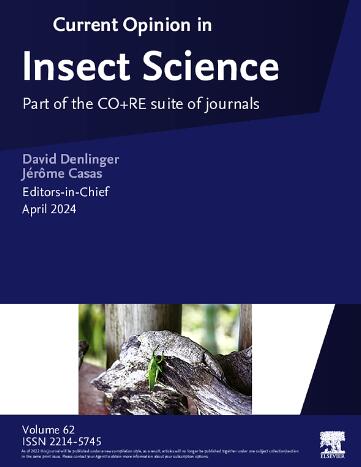白蚁群居性的起源:遗传一夫一妻制是必要的吗?
IF 4.8
1区 农林科学
Q1 BIOLOGY
引用次数: 0
摘要
一个普遍的假设是,“严格的遗传一夫一妻制”是膜翅目和等翅目昆虫社会性起源的普遍先决条件。然而,白蚁并不容易符合这种情况,特别是因为白蚁的姐妹群体,食木蟑螂隐尾虫,最近被发现是社会上的,而不是基因上的一夫一妻制。白蚁可能是在一个优先考虑氮保护的生态环境中,从体型庞大、身体健壮、专性亚社会性的蟑螂进化而来的。向群居性的转变可以从这样一个起点开始,分别通过重新分配可用的氮资源,将育儿和防御性父母职责依次委托给年轻的异体父母和士兵。每个社会转变都依赖于先前的状态,最后一步,从亲代防御到士兵种姓的起源,与亲代体型和角质层投资的减少共同进化,从而释放氮用于亲代繁殖和士兵的角质层盔甲。然而,这种重新分配关键保留区的后果之一是对交配系统的影响:在分散和群体建立过程中,现在更小、更脆弱的alates受到了无情的捕食压力。群居、串联奔跑、仓促的择偶以及立即和永久的隔离可以被视为对抗这种选择压力的措施,从而加强了遗传上的一夫一妻制。我们提出,在现存白蚁的早期群体中发现的任何遗传一夫一妻制都可能是白蚁向群居性过渡的结果,而不是原因;如果是这样,这是一种衍生的交配系统,可能是白蚁进化中的适应度成本。本文章由计算机程序翻译,如有差异,请以英文原文为准。
Origin of eusociality in termites: was genetic monogamy essential?
A prevalent hypothesis is that ‘strict genetic monogamy’ was a universal prerequisite for the origin of eusociality in Hymenoptera and Isoptera. Termites, however, do not fit easily into this scenario, particularly since the sister group of termites, the wood-feeding cockroach Cryptocercus, was recently found to be socially but not genetically monogamous. Termites likely evolved from large, physically robust, obligately subsocial cockroaches in an ecological setting where nitrogen conservation was prioritized. The shift to eusociality can originate from such a starting point via sequential delegation of brood care and defensive parental duties to young alloparents and soldiers, respectively, facilitated by reallocation of available nitrogenous resources. Each social transition was dependent on the prior state, and the final step, the shift from parental defense to origination of a soldier caste, coevolved with a decrease in parental body size and cuticular investment, thus freeing nitrogen for channeling into parental reproduction and cuticular armoring of soldiers. One consequence of this reallocation of critical reserves, however, was on the mating system: the now smaller, vulnerable alates were subjected to relentless predation pressure during dispersal and colony foundation. Swarming, tandem running, hasty mate choice, and immediate and permanent sequestration can be viewed as countermeasures to this selection pressure, enforcing genetic monogamy. We propose that any genetic monogamy detected in incipient colonies of extant termites may be a consequence, rather than a cause, of the initial transition to eusociality; if so, it is a derived mating system that may be a fitness cost in termite evolution.
求助全文
通过发布文献求助,成功后即可免费获取论文全文。
去求助
来源期刊

Current opinion in insect science
BIOLOGYECOLOGYENTOMOLOGY-ECOLOGY
CiteScore
10.40
自引率
1.90%
发文量
113
期刊介绍:
Current Opinion in Insect Science is a new systematic review journal that aims to provide specialists with a unique and educational platform to keep up–to–date with the expanding volume of information published in the field of Insect Science. As this is such a broad discipline, we have determined themed sections each of which is reviewed once a year.
The following 11 areas are covered by Current Opinion in Insect Science.
-Ecology
-Insect genomics
-Global Change Biology
-Molecular Physiology (Including Immunity)
-Pests and Resistance
-Parasites, Parasitoids and Biological Control
-Behavioural Ecology
-Development and Regulation
-Social Insects
-Neuroscience
-Vectors and Medical and Veterinary Entomology
There is also a section that changes every year to reflect hot topics in the field.
Section Editors, who are major authorities in their area, are appointed by the Editors of the journal. They divide their section into a number of topics, ensuring that the field is comprehensively covered and that all issues of current importance are emphasized. Section Editors commission articles from leading scientists on each topic that they have selected and the commissioned authors write short review articles in which they present recent developments in their subject, emphasizing the aspects that, in their opinion, are most important. In addition, they provide short annotations to the papers that they consider to be most interesting from all those published in their topic over the previous year.
 求助内容:
求助内容: 应助结果提醒方式:
应助结果提醒方式:


